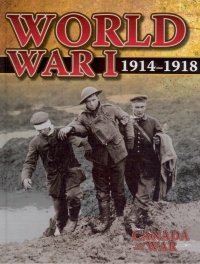| ________________
CM . . . . Volume XVII Number 29 . . . . April 1, 2011
excerpt:
The two books of this series offer a remarkably clear and concise account of the causes and courses of World War I and II. Both books have a double page map close to the beginning of the book indicating the areas allied with Canada and Great Britain, those allied with Germany, and those that remained neutral; they were indeed world wars. The series is definitely written from a Canadian perspective, highlighting the various theatres where Canadian troops played a significant role. Emphasis is, of course, on the battles that could be called victories - Vimy Ridge, Passchendale, Juno Beach - but the costs in men and material are not ignored. The books are not a glorification of war, and we didn't always win the battles. For example, World War II:1939-1945 does not attempt to make the Dieppe disaster anything but an enormous planning blunder in which more than 2000 Canadians died or were taken prisoner or even try to 'justify' it and events like it by citing the effect they had on the home front in stiffening the resolve to oppose Hitler "on the beaches,... on the landing grounds", etc. Both wars had a big effect on life back home in Canada. Women joined the workforce and enjoyed the new freedoms of jobs and money of their own. Rationing created hardships for everyone. Conscription was a political issue in both wars, as was racism. All of these issues are touched on, though obviously not in any great detail. The aftermaths of the wars - the Winnipeg General Strike in 1919, votes for women, the baby boom after 1945 - are mentioned briefly, and there are a couple of pages in each book giving charts, graphs, and tables of relevant numbers regarding costs and casualties. It is curious that Canada had no civilian casualties in World War II and 2000 in World War I (perhaps an indication of how many more jobs were classified as military by 1939?). The science, technology, weaponry, and heros of the two wars are likely to be very popular sections of these books. It was good to see William Stephenson profiled as well as the flying aces Billy Bishop and Buzz Bearling; we are not just treated to a list of Victoria Cross winners. As with any overview of this sort, it would be nice to have more details of the bits that interest any reader particularly. But that is the function of an overview - to whet the appetite for more, and to give some suggestions where the 'more' can be found. No websites or books are specifically mentioned, but the possibility of further research and some leading questions are the concluding section of each book. Combined with an index and a glossary, these books are a good beginning to research on the topic of these two wars, as well as being of general interest to the young reader wanting to know just a bit. Highly Recommended. Mary Thomas works in an elementary school library in Winnipeg, MB, and wishes that guns and war were a little less popular subjects with her students.
To comment
on this title or this review, send mail to cm@umanitoba.ca.
Copyright © the Manitoba Library Association. Reproduction for personal
use is permitted only if this copyright notice is maintained. Any
other reproduction is prohibited without permission.
NEXT REVIEW |
TABLE OF CONTENTS FOR THIS ISSUE
- April 1, 2011.
AUTHORS |
TITLES |
MEDIA REVIEWS |
PROFILES |
BACK ISSUES |
SEARCH |
CMARCHIVE |
HOME |

